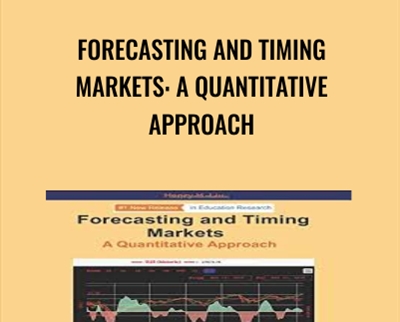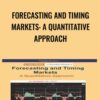$27.00
[Update June 16, 2020: The author started live-trading on March 9, 2020, with his Fidelity IRA account and a list of 38 symbols, using the models described in this book. Up to now, his portfolio has achieved a net profit of 32.78% as of June 15, 2020, which is impressive given the market volatility induced by the COVID-19.
 Purchase this course you will earn 27 Points worth of $2.70
Purchase this course you will earn 27 Points worth of $2.70Elevate your skills with the Forecasting and Timing Markets: A Quantitative Approach – Henry H. Liu course, available for just $27.00 on Utralist.com! Browse our curated selection of over 60,000 downloadable digital courses across diverse Uncategorized. Benefit from expert-led, self-paced instruction and save over 80%. Start learning smarter today!
[Update June 16, 2020: The author started live-trading on March 9, 2020, with his Fidelity IRA account and a list of 38 symbols, using the models described in this book. Up to now, his portfolio has achieved a net profit of 32.78% as of June 15, 2020, which is impressive given the market volatility induced by the COVID-19. The author's performance of 32.78% net gain beats all market index ETFS of DIA(8.22%), SPY (12.22%), QQQ (23.34%), as well as last year's top 5 mutual funds of FSPHX (11.77%), FOCPX (22.85%), WMICX (25.95%), VINIX (10.95%), and FSCSX (20.84%), respectively. This verifies the author's belief that "buy and hold (bah) or buy and pray (bap) is not the best way to invest!". Visit www dot alphacovaria dot com for more live/paper trading performance comparisons].
Financial markets are essentially time-series data-driven events consisting of valleys, peaks, and in-betweens of ups and downs. For more than a century, many pioneers had attempted to come up with various theoretical models to facilitate forecasting and timing market moves. For example, as early as in 1902, or 117 years ago, S. A. Nelson, a friend of Charles H. Dow, attempted to explain Dow’s methods in his book titled The A B C of Stock Speculation, which became later known as “the Dow Theory.” 20 years later in 1922, William Peter Hamilton carried on and wrote the book The Stock Market Barometer, which explained the Dow Theory in more detail. More recently in the last few decades, the advent of advanced computing technologies helped create numerous technical indicators, such as Relative Strength Index (RSI) by J. Welles Wilder (1978), Bollinger Bands (BB) by John Bollinger (2002), Moving Average Convergence Divergence (MACD) by Gerald Appel (2005), Stochastic Oscillator (SO) by George Lane (2007), to name a few. Those powerful theories and indicators have been heavily studied and well-known in the financial circle. However, they are empirical and lack quantitative verifications out of solid back-test results; or they might just be proprietary gauges locked in the computing facilities of those mega financial firms and thus not readily available to the general public.
Based on the law of large numbers and ensemble machine learning, this text attempts to help explore to what extent we can actually forecast and time markets if it’s impossible to do so precisely. For this purpose, the author developed a research-oriented, indicator-based system trading tool, named AlphaCovaria, to help demonstrate how to use various simplest, readily available technical indicators to forecast and time markets approximately while eliminating subjective speculations at the same time for potentially maximizing profits of trading with a formula-driven approach. This tool consists of three major programs named AlphaCurve, AlphaDriver, and BTDriver, respectively. The AlphaCurve charting tool provides intuitive, all-in-one, specially designed and constructed charts in color to help visualize how various forecasting and timing models work with the price movements of chosen securities and indicators. The AlphaDriver, a data-crunching tool, feeds AlphaCurve with security price movement data and various computed indicator stats by calling a commercial market data provider with specified timeframes of historic, intraday and real-time. The BTDriver is a back-test driver, which also aggregates profit profiles with a given look-back period, thus enabling the AlphaDriver to generate buy/sell signals on the fly dynamically and adaptively, rather than statically.
The text is made concise and precise of about 100 pages only, with an Appendix illustrating how you can use your iPhone/iPad with Yahoo Finance Mobile App to facilitate your research and investing. Forecasting and timing markets are achievable if proper indicators, models and strategies are utilized with modern computing technologies.
Get Forecasting and Timing Markets: A Quantitative Approach – Henry H. Liu, Only Price $39
Tag: Forecasting and Timing Markets: A Quantitative Approach – Henry H. Liu Review. Forecasting and Timing Markets: A Quantitative Approach – Henry H. Liu download. Forecasting and Timing Markets: A Quantitative Approach – Henry H. Liu discount.
Cultivate continuous growth with the Forecasting and Timing Markets: A Quantitative Approach – Henry H. Liu course at Utralist.com! Unlock lifetime access to premium digital content, meticulously designed for both career advancement and personal enrichment.
- Lifetime Access: Enjoy limitless access to your purchased courses.
- Exceptional Value: Benefit from savings up to 80% on high-quality courses.
- Secure Transactions: Your payments are always safe and protected.
- Practical Application: Gain real-world skills applicable to your goals.
- Instant Accessibility: Begin your learning journey immediately after buying.
- Device Compatible: Access your courses seamlessly on any device.
Transform your potential with Utralist.com!
Related products
= 125 Points
Uncategorized
= 95 Points
= 84 Points
Uncategorized
= 35 Points
Uncategorized
= 85 Points
= 125 Points
Uncategorized
= 85 Points
= 72 Points





